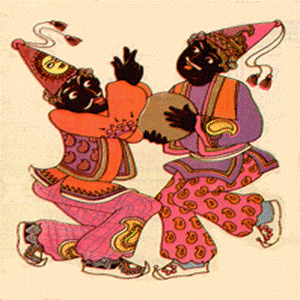
Arbaab-e khod-am salaamo ´aleykom,
Arbaab-e khod-am sar-eto baalaa kon!
Arbaab-e khod-am be man nigaa kon,
Arbaab-e khod-am lotf-i be maa kon.
Arbaab-e khod-am boz-boz-e qhandi,
Arbaab-e khod-am cheraa nemikhandi?
Haaji Firuz blackens his face, wears very colorful clothes, usually—but not always—red, and always a hat that is sometimes long and cone-shaped. His songs, quite traditional in wording and melody, are very short repetitive ditties. (Bolukbâši, 1977, pp. 108-9; idem, 2001, p. 38).Occasionally, the Haaji Firuz, whose income depends on his ability and talent to entertain by humor, manages to work other traditional songs into his routine. One of the most popular of these, goes as follows:
Beshkan beshkan-e, beshkan!
Man nemishkanam, beshkan!
Injaa beshkanam yaar gel-e daar-e,
Unjaa beshkanam yaar gel-e daar-e,
In siaah-e bichaare cheqad hosele daar-e !! Classical Persian sources that mention many folk entertainers do not refer to Haaji Firuz at all, nor is he mentioned in casual reference in poetry or prose of the classical period. There can be little doubt, however, that Haaji Firuz has virtually replaced all the other New Year entertainers of the past such as Mir-e Nowruzi, Ghul-e biaabaani, Aatash-afruz, etc. In a paper originally published in 1983, agreed with him on this subject.
**
Ostaad Haashem Razi,has many publications on Iran,Zoroasterian subjects,mythology &…..unfortunately for some reasons unknown to me the faculty members of Historical Linguistics ,Tehran university,were not in good terms with him?!so I had to meet him w/o knowledge of them in Farvahar bookstore(In Kaakh st) & satisfy mr thirst for a comparative study of Pre-Islamic studies.His theories were mostly not based on academic studies!.
*****************************
SOURCES:
1-Mehrdad Bahar, “Nowruz, zamaan-e moqaddas,” 1362 /1983, pp. 772-78.
2-Jostaar-i chand dar farhang-e Iran, 2nd ed., Tehran, 1374 /1995, pp. 221-29.
3-Haashem Razi, Nowruz, sawaabeqh-e taarikhi taa emruz, Tehran, 1358/1979.
4-´Ali Bolukbaashi, Nowruz: jashn-e now-zaa`i-e aafarinesh, 2nd ed. Tehran, 2001.






